Tracking Cash and Voucher Assistance
Grand Bargain signatories committed to increase the use of CVA, and to use common markers to measure these increases. Although the volume of CVA is beginning to be more effectively tracked, technical and policy challenges remain. These include:
- Defining what data to collect, and how
- Ensuring commitment to and use of data categories and systems
- Addressing shortcomings of existing reporting systems which have often not been designed to include or disaggregate cash, vouchers, and other modalities
- Reaching common agreement on standard categories for reporting to avoid incomplete and inconsistent data.
Current priorities
From 2017 to 2019, the CALP Network co-led the Grand Bargain Cash sub-workstream on Tracking CVA with DG ECHO, with the main objective of agreeing minimum requirements for tracking CVA. This includes the integration of CVA into key interagency reporting systems and platforms, namely OCHA’s Financial Tracking Service (FTS) and HPC Project Module, the International Aid Transparency Initiative’s (IATI) Data Standard, and 3W (Who does What, Where) reporting. The sub-workstream on Tracking CVA has now been merged into the Efficiency, Effectiveness and Value for Money sub-workstream, which the CALP Network will continue to co-lead.
Featured content

Tracking Cash & Voucher Assistance Workshop – Part 2: Report
Presentation
Do you want to read the latest on discussions on how to best track cash and voucher assistance in global interagency reporting systems? The CALP Network and ECHO have just released Tracking Cash & Voucher Assistance Workshop – Part 2: Report. Key recommendations emerging from the workshop are summarized below. These will be used in the coming months as a basis to develop guidance for...

Measuring Cash Transfer Programming – Scoping study
Report
This scoping study explores technical and policy issues that are constraining progress towards better measurement and reporting of Cash Transfer Programming (CTP) and addresses these to identify ways forward. The study was developed with the following objectives: • Map and document how different implementing agencies and donors are measuring cash and voucher programming data at the...

Tracking Cash and Voucher Assistance: Agreements, recommendations and minimum requirements from the Grand Bargain cash workstream
Guidelines and Tools
This document comprises the key outputs of the work undertaken through the Tracking Cash and Voucher Assistance (CVA) Working Group from 2017 to 2019. The Tracking CVA Working Group was established as the
platform for engagement and decision-making for the sub-workstream on Tracking CVA, which is part of the Grand Bargain Cash Workstream. The Tracking CVA sub-workstream was co-led by the the...
Thematic lead
Latest
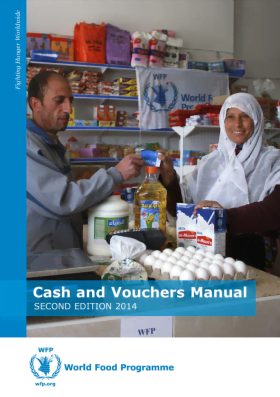
Cash and Vouchers Manual – Second edition
Guidelines and Tools
This second edition of the Cash and Vouchers Manual captures the latest corporately endorsed business processes and procedures, providing the most up-to-date tools (i.e. analytical, assessment, monitoring) that have been developed through close intra-departmental collaboration between Headquarters...
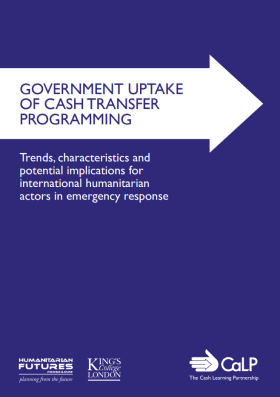
Government Uptake of Cash Transfer Programming: Trends, characteristics and potential implications for international humanitarian actors in emergency response
Policy paper
Trends, characteristics and potential implications for international humanitarian actors in emergency response. This thematic report has been undertaken as part of a 2013 research study entitled, Is Cash Transfer Programming ‘Fit for the Future’? The research was commissioned by the the CALP...
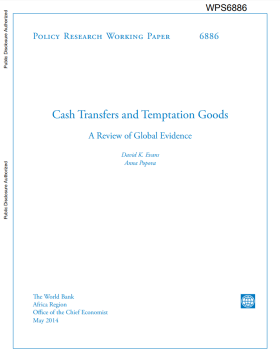
Cash Transfers and Temptation Goods: A review of global evidence
Report
Cash transfers have been demonstrated to improve education and health outcomes and alleviate poverty in various contexts. However, policy makers and others often express concern that poor households will use transfers to buy alcohol, tobacco, or other “temptation goods”. This paper reviews 19...
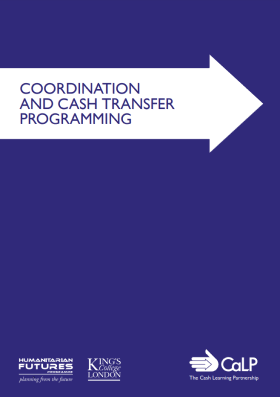
Coordination and Cash Transfer Programming
Policy paper
This thematic report has been undertaken as part of a 2013 research study entitled, Is Cash Transfer Programming ‘Fit for the Future’? The research was commissioned by the the CALP Network and undertaken by the Humanitarian Futures Programme (HFP), King’s College London. The overall...

Financing of Cash Transfer Programming
Policy paper
This thematic report has been undertaken as part of a 2013 research study entitled, Is Cash Transfer Programming ‘Fit for the Future’? The research was commissioned by the the CALP Network and undertaken by the Humanitarian Futures Programme (HFP), King’s College London. The overall...
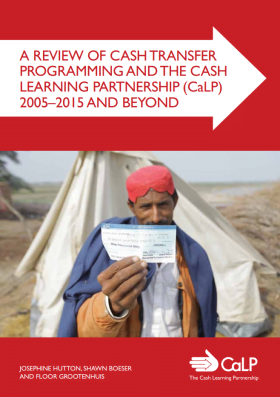
A Review of Cash Transfer Programming and the the CALP Network 2005–2015 and Beyond
Report
The core purpose of this review, commissioned by the CALP Network, is to evaluate the CALP Network’s progress since inception and examine the status and continued needs of cash programming in emergencies. Cash transfer programming (CTP) represents a significant shift in the way humanitarian aid can...
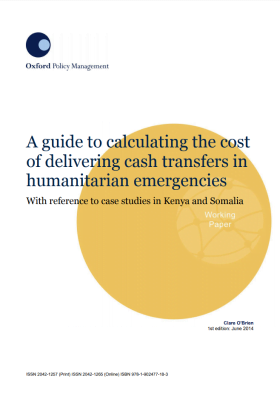
A Guide to Calculating the Cost of Delivering Cash Transfers in Humanitarian Emergencies – With reference to case studies in Kenya and Somalia
Report
The emergence of cash transfers as a viable alternative to in-kind aid – such as food or shelter materials – for households affected by humanitarian disasters has been documented for some years now. Under certain conditions, when local markets are able to accommodate increased demand and prices will...
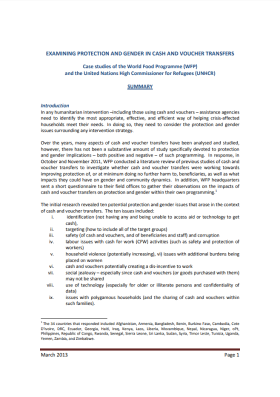
Examining Protection and Gender in Cash and Voucher Transfers – Summary
Report
In any humanitarian intervention – including those using cash and vouchers – assistance agencies need to identify the most appropriate, effective, and efficient way of helping crisis-affected households meet their needs. In doing so, they need to consider the protection and gender issues surrounding...
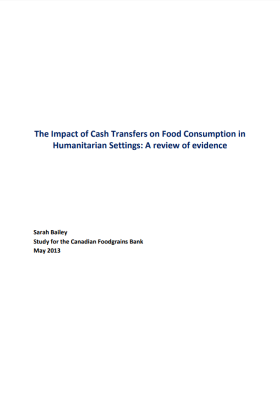
The Impact of Cash Transfers on Food Consumption in Humanitarian Settings: A review of evidence
Report
In order to make informed decisions on when to use cash, vouchers and food aid, it is important to understand evidence on their appropriateness and effectiveness in achieving certain objectives. A main objective of the Canadian Foodgrains Bank is to improve food consumption in emergencies, and this paper...
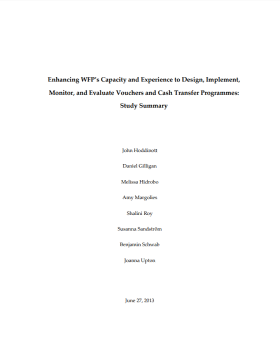
Enhancing WFP’s Capacity and Experience to Design, Implement, Monitor, and Evaluate Vouchers and Cash Transfer Programmes: Study summary
Report
With support from the Government of Spain, and in partnership with the World Food Programme (WFP), researchers from the International Food Policy Research Institute (IFPRI) evaluated four pilot projects to assess the comparative performance of cash transfers, food payments, and vouchers on household food...
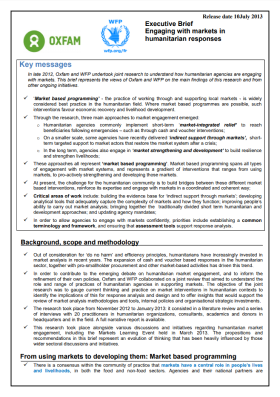
Executive Brief: Engaging with markets in humanitarian responses
Policy paper
In late 2012-early 2013, WFP and Oxfam collaborated on a piece of research that aimed to understand how humanitarian agencies are currently engaging with markets and how this work might evolve. The research culminated in the writing of this brief.
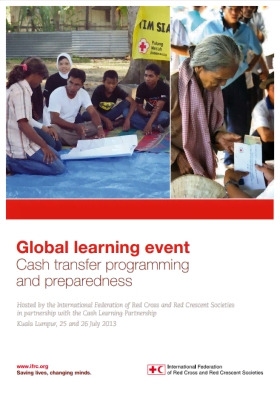
Global Learning Event Report: Cash transfer programming and preparedness
Report
As the investment in cash transfer programming (CTP) continues to grow, there is a desire to find ways to carry out this approach faster, more often and more effectively. As a result, the integration of CTP into preparedness and contingency planning is becoming more important. A global learning event on...
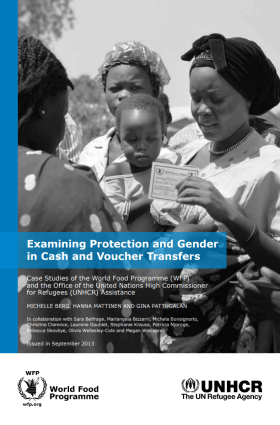
Examining Protection and Gender in Cash and Voucher Transfers – Report
Report
With cash and voucher transfers increasing as a form of humanitarian assistance, the World Food Programme (WFP) and the UN Refugee Agency (UNHCR) teamed up to study the potential protection and gender impact of such transfers. While much research had been done about economic and market impacts of cash and...
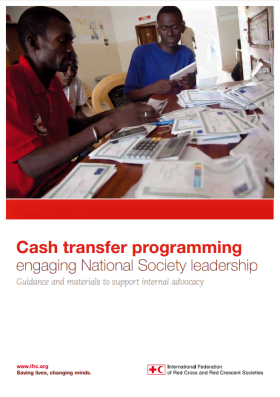
Cash Transfer Programming Engaging National Society Leadership: Guidance and materials to support internal advocacy
Guidelines and Tools
This guidance provides the materials required to run an awareness session for senior representatives of a National Society on the nature of cash transfer programming, its challenges and benefits. National Societies work in different contexts and as such the materials will need to be adapted to suit the...

Comparative Review of Market Assessments Methods, Tools, Approaches and Findings
Guidelines and Tools
Against a backdrop of climate change, global economic crises and commodity market volatility, food security experts are increasingly interested in deepening their understanding of how markets work. In 2011, the the CALP Network commissioned this study, which aimed to assess how we are currently analysing...

The Crisis in the Sahel – Special Feature
Report
The special feature of this issue of Humanitarian Exchange focuses on the humanitarian crisis in the Sahel region of Africa, where aid agencies estimate that more than 18 million people are affected by food insecurity. In response to this crisis, cash and vouchers programming has been largely used. In...
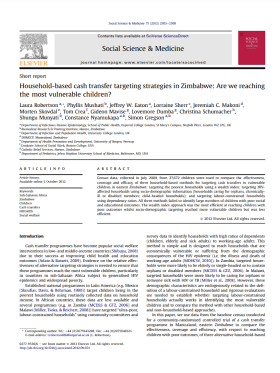
Household-Based Cash Transfer Targeting Strategies in Zimbabwe: Are we reaching the most vulnerable children?
Report
Census data, collected in July 2009, from 27,672 children were used to compare the effectiveness, coverage and efficacy of three household-based methods for targeting cash transfers to vulnerable children in eastern Zimbabwe: targeting the poorest households using a wealth index; targeting HIV affected...
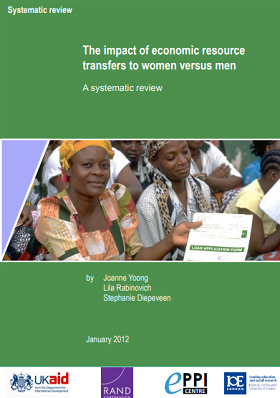
The Impact of Economic Resource Transfers to Women versus Men: A Systematic Review
Report
This systematic review examined the question: “what is the evidence of the impact on family well-being of giving economic resources to women relative to the impact of giving them to men?” This review is of interest to policy-makers and funders in developed and developing countries, given the recent...
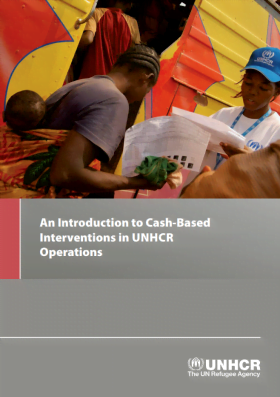
An Introduction to Cash-Based Interventions in UNHCR Operations
Policy paper
This document provides an introduction and basic guidance on the use of cash-based interventions and tackles key issues of relevance to UNHCR in the form of questions and answers. It also provides an overview of UNHCR’s experience in using cash-based interventions.

Comparative Review of Market Assessments Methods, Tools, Approaches and Findings – SWOT Analysis
Guidelines and Tools
This document makes a comparative review of different market assessments methods,tools, approaches and findings. A swot analysis of the Emergency Market Mapping Analysis (EMMA), Market Information and Food Insecurity Response Analysis (MIFIRA) and World Food Programme Trader Survey (WFP TS) is...



